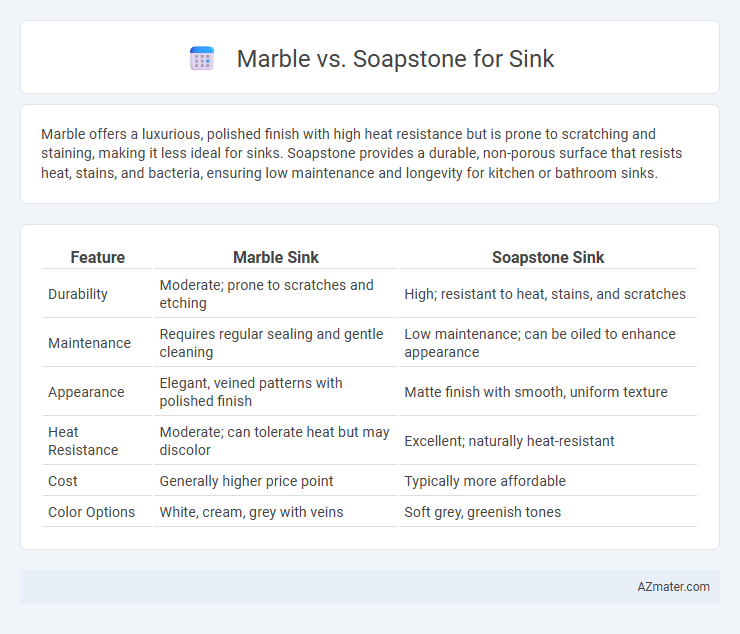Marble offers a luxurious, polished finish with high heat resistance but is prone to scratching and staining, making it less ideal for sinks. Soapstone provides a durable, non-porous surface that resists heat, stains, and bacteria, ensuring low maintenance and longevity for kitchen or bathroom sinks.
Table of Comparison
| Feature | Marble Sink | Soapstone Sink |
|---|---|---|
| Durability | Moderate; prone to scratches and etching | High; resistant to heat, stains, and scratches |
| Maintenance | Requires regular sealing and gentle cleaning | Low maintenance; can be oiled to enhance appearance |
| Appearance | Elegant, veined patterns with polished finish | Matte finish with smooth, uniform texture |
| Heat Resistance | Moderate; can tolerate heat but may discolor | Excellent; naturally heat-resistant |
| Cost | Generally higher price point | Typically more affordable |
| Color Options | White, cream, grey with veins | Soft grey, greenish tones |
Introduction to Marble and Soapstone Sinks
Marble sinks are renowned for their elegant and luxurious appearance, featuring unique veining patterns and a smooth, polished surface that enhances bathroom and kitchen aesthetics. Soapstone sinks offer exceptional durability and resistance to heat and stains, with a matte, natural finish that deepens in color over time, providing a rustic yet sophisticated appeal. Both materials require specific maintenance: marble demands careful sealing to prevent etching, while soapstone needs periodic oiling to maintain its rich, dark patina.
Appearance and Aesthetic Differences
Marble sinks feature natural veining patterns that create a luxurious and elegant appearance, with a polished surface that enhances light reflection and highlights intricate details. Soapstone sinks offer a matte, smooth finish with a muted, earthy tone that develops a unique patina over time, lending a warm and rustic charm to kitchens and bathrooms. The choice between marble's opulent sheen and soapstone's subtle texture depends on the desired aesthetic impact and maintenance preferences in sink design.
Durability and Longevity
Marble sinks offer a luxurious appearance but are more prone to scratches, stains, and etching, affecting their durability and longevity in high-use environments. Soapstone sinks boast exceptional resistance to heat, stains, and chemicals, making them highly durable and capable of maintaining their appearance for decades with minimal maintenance. Choosing soapstone ensures a long-lasting sink that withstands daily wear better than marble, which requires more careful upkeep to preserve its beauty.
Maintenance and Care Requirements
Marble sinks demand regular sealing to prevent staining and etching due to their porous nature, requiring gentle cleaning with pH-neutral cleaners to maintain their polished surface. Soapstone sinks offer superior resistance to acids and stains, needing only occasional oiling to enhance their natural patina and prevent drying or cracking. Both materials require careful maintenance, but soapstone's durability provides a lower-maintenance alternative compared to the more delicate marble.
Stain and Scratch Resistance
Soapstone offers superior stain and scratch resistance compared to marble, making it an ideal choice for sink surfaces in busy kitchens. Its dense, non-porous composition resists acidic and oily substances, preventing discoloration and surface damage common with marble under heavy use. Marble, while elegant, is softer and more porous, requiring regular sealing to mitigate stains and scratches from everyday wear.
Cost Comparison: Marble vs Soapstone
Marble sinks typically range from $150 to $600, reflecting their luxurious appearance and higher maintenance costs, while soapstone sinks generally cost between $250 and $800, offering superior durability and resistance to stains and heat. Marble requires periodic sealing to prevent staining and etching, which adds to its overall expense, whereas soapstone's natural patina develops over time without needing extensive upkeep. Homeowners often choose soapstone for long-term cost efficiency despite the higher initial investment, while marble appeals to those prioritizing aesthetic elegance at a potentially lower upfront cost.
Installation Considerations
Marble sinks require precise sealing and support due to their porous nature and susceptibility to chipping during installation, making professional handling essential. Soapstone sinks, being denser and non-porous, offer easier installation with less risk of damage and minimal sealing needs, which reduces long-term maintenance. Both materials benefit from proper countertop support, but soapstone's durability allows for more flexibility in mounting options without compromising integrity.
Environmental Impact and Sustainability
Marble sinks have a higher environmental impact due to intensive quarrying and energy consumption during extraction and processing, contributing to habitat disruption and carbon emissions. Soapstone, sourced from more sustainable mining practices with lower energy requirements, offers greater durability and resistance to chemicals, reducing the need for frequent replacement. Its natural composition supports eco-friendly manufacturing and longer lifecycle, making it a more sustainable choice for environmentally conscious homeowners.
Pros and Cons of Marble Sinks
Marble sinks offer a luxurious and elegant appearance with natural veining that adds unique character to kitchens and bathrooms, and their heat resistance makes them suitable for various uses. However, marble is porous and can stain or etch easily from acidic substances, requiring regular sealing and careful maintenance to preserve its beauty. Durability is moderate compared to harder stones like granite or quartz, making marble sinks more prone to scratches and chips over time.
Pros and Cons of Soapstone Sinks
Soapstone sinks offer exceptional durability and resistance to heat and stains, making them ideal for heavy kitchen use. Their natural, non-porous surface requires minimal sealing and is less prone to bacterial growth compared to marble. However, soapstone can scratch and darken over time, which may require periodic oiling to maintain its appearance.

Infographic: Marble vs Soapstone for Sink
 azmater.com
azmater.com